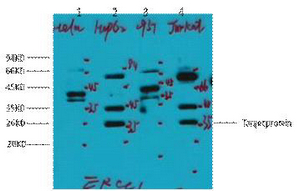LAB (Phospho Tyr136) rabbit pAb
- Catalog No.:YP1719
- Applications:WB
- Reactivity:Human;Mouse;Rat
- Target:
- LAB
- Gene Name:
- LAT2 LAB NTAL WBS15 WBSCR15 WBSCR5 HSPC046
- Protein Name:
- LAB (Phospho-Tyr136)
- Human Gene Id:
- 7462
- Human Swiss Prot No:
- Q9GZY6
- Mouse Gene Id:
- 56743
- Mouse Swiss Prot No:
- Q9JHL0
- Rat Gene Id:
- 317676
- Rat Swiss Prot No:
- Q8CGL2
- Immunogen:
- Synthesized peptide derived from human LAB (Phospho-Tyr136)
- Specificity:
- This antibody detects endogenous levels of LAB (Phospho-Tyr136) at Human, Mouse,Rat
- Formulation:
- Liquid in PBS containing 50% glycerol, 0.5% BSA and 0.02% sodium azide.
- Source:
- Polyclonal, Rabbit,IgG
- Dilution:
- WB 1:500-2000
- Purification:
- The antibody was affinity-purified from rabbit serum by affinity-chromatography using specific immunogen.
- Concentration:
- 1 mg/ml
- Storage Stability:
- -15°C to -25°C/1 year(Do not lower than -25°C)
- Other Name:
- Linker for activation of T-cells family member 2 (Linker for activation of B-cells) (Membrane-associated adapter molecule) (Non-T-cell activation linker) (Williams-Beuren syndrome chromosomal region 15 protein) (Williams-Beuren syndrome chromosomal region 5 protein)
- Observed Band(KD):
- 30kD
- Background:
- This gene is one of the contiguous genes at 7q11.23 commonly deleted in Williams syndrome, a multisystem developmental disorder. This gene consists of at least 14 exons, and its alternative splicing generates 3 transcript variants, all encoding the same protein. [provided by RefSeq, Jul 2008],
- Function:
- disease:Defects in LAT2 may be a cause of certain cardiovascular and musculo-skeletal abnormalities observed in Williams-Beuren syndrome (WBS) [MIM:194050]. WBS is a rare developmental disorder. It is a contiguous gene deletion syndrome involving genes from chromosome band 7q11.23.,function:Involved in FCER1 (high affinity immunoglobulin epsilon receptor)-mediated signaling in mast cells. May also be involved in BCR (B-cell antigen receptor)-mediated signaling in B-cells and FCGR1 (high affinity immunoglobulin gamma Fc receptor I)-mediated signaling in myeloid cells. Couples activation of these receptors and their associated kinases with distal intracellular events through the recruitment of GRB2.,PTM:May be polyubiquitinated.,PTM:Phosphorylated on tyrosines following cross-linking of BCR in B-cells, FCGR1 in myeloid cells, or FCER1 in mast cells; which induces the recruitment of GRB2.,s
- Subcellular Location:
- Cell membrane ; Single-pass type III membrane protein . Present in lipid rafts.
- Expression:
- Highly expressed in spleen, peripheral blood lymphocytes, and germinal centers of lymph nodes. Also expressed in placenta, lung, pancreas and small intestine. Present in B-cells, NK cells and monocytes. Absent from T-cells (at protein level).
- June 19-2018
- WESTERN IMMUNOBLOTTING PROTOCOL
- June 19-2018
- IMMUNOHISTOCHEMISTRY-PARAFFIN PROTOCOL
- June 19-2018
- IMMUNOFLUORESCENCE PROTOCOL
- September 08-2020
- FLOW-CYTOMEYRT-PROTOCOL
- May 20-2022
- Cell-Based ELISA│解您多样本WB检测之困扰
- July 13-2018
- CELL-BASED-ELISA-PROTOCOL-FOR-ACETYL-PROTEIN
- July 13-2018
- CELL-BASED-ELISA-PROTOCOL-FOR-PHOSPHO-PROTEIN
- July 13-2018
- Antibody-FAQs
- Products Images

- Western Blot analysis of 1 HepG2 cell, 2 Serum-free treated ,using primary antibody at 1:1000 dilution. Secondary antibody(catalog#:RS23920) was diluted at 1:10000



